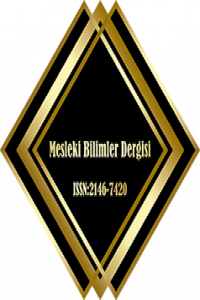Piroklastik Kayaçların Elastisite Modülünün Agrega/Kayaç Özellikleri Kullanılarak Modellenmesi
piroklastik kayaçlar, elastisite modülü, sertlik
___
- Aufmuth, R.E., (1973), A systematic determination of engineering criteria for rocks. Bull Assoc Eng Geol, 11: 235-245.
- Babuska, V., Pros, Z., (1984), Velocity anisotropy in granodiorite and quartzite due to the distribution of microcracks. Geophys J R Astron Soc, 76(1): 121-127.
- Baykasoğlu, A., Güllü, H., Çanakçı, H., Özbakır, L., (2008), Prediction of compressive and tensile strength of limestone via genetic programming. Expert Syst Appl, 35(1): 111-123.
- Birch, F., (1960), The velocity of compressional waves in rocks 10 kbars: Part 1 J Geophys Res, 65(4): 1083-1102.
- Chen, C.S., Pan, E., Amadei, B., (1998), Determination of deformability and tensile strength of anisotropic rock using Brazilian tests. Int J Rock Mech Min Sci, 35(1): 43–61.
- Claesson, J., Bohloli, B., (2002), Brazilian test: stress field and tensile strength of anisotropic rocks using an analytical solution. Int J Rock Mech Min Sci, 39(8): 991–1004.
- Çanakci, H., Pala, M., (2007), Tensile strength of basalt from a neural network. Eng Geol, 94(1): 10-18.
- Çobanoğlu, İ., Çelik, S.B., (2008), Estimation of uniaxial compressive strength from point load strength, Schmidt hardness and P-wave velocity. Bull Eng Geol Environ, 67: 491-498.
- Deere, D.U., Miller, R.P., (1966), Engineering classification and index properties for intact rocks. Tech. Report. Air Force Weapons Lab. New Mexico, No. AFNL-TR, 65-116.
- Diamantis, K., Gartzos, E., Migiros, G., (2009), Study on uniaxial compressive strength, point load strength index, dynamic and physical properties of serpentinites from Central Greece: test results and empirical relations. Eng Geol, 108:199-207.
- Gaviglio, P., (1989), Longitudinal waves propagation in a limestone: the relationship between velocity and density. Rock Mech Rock Eng, 22(4): 299-306.
- Inoue, M., Ohomi, M., (1981), Relation between Unixial compressive strength and elastic wave velocity of soft rock. IN: Akai K,
- Mayashi M, Nishimatsu Y, editors. Proceeding of the Int. Symposium on Weak Rock, Tokyo, p. 9-13.
- ISRM, (1981), Rock characterization, testing and monitoring – Commission on standardization laboratory and field results. Suggested methods for determining hardness and abrasiveness of rocks. Part 4, p:102-103, Pergamon, Oxford.
- Jamshidi, A., Nikudel, M.R., Khamehchiyan, M., Sahamieh, R.Z., Abdi, Y., (2016), A correlation between P-wave velocity and Schmidt hardness with mechanical properties of travertine building stones. Arab J Geocsi, 9(10): 568.
- Kılıç, A., Teymen, A., (2008), Determination of mechanical properties of rocks using simple methods. Bull Eng Geol Environ, 67(2): 237-244.
- King, M.S., Chaudhry, N.A., Shakeel, A., (1995), Experimental ultrasonic velocities and permeability for sandstones with aligned cracks, Int J Rock Mech Min Sci Geomech Abstr, 32(2): 155-163.
- Kurtuluş, C., Sertçelik, F., Sertçelik, I., (2016), Correlating physico-mechanical properties of intact rocks with P-wave velocity. Acta Geodaetica et Geophysica, 51(3): 571-582.
- Mccann, D.M., Culshaw, M.G., Northmore, K.J., (1990), Rock mass assessment from seismic measurements. In: Bell, Culshaw, Cripps, Coffey (eds) Fields testing in Eng Geol, Geol. Soc. Eng. Ape. Pub., 6(1): 257-266.
- Minaeian, B., Ahangari, K., (2013), Estimation of uniaxial compressive strength based on P-wave and Schmidt hammer rebound using statistical method. Arab J Geocsi, 6(6):1925-1931.
- Sachpazis, C.I., (1990), Correlating Schmidt hardness with compressive strength and Young’s modulus of carbonate rocks. Bull Int Assoc Eng Geol, 42(1): 75-83.
- Sharma, P.K., Singh, T.N., (2008), A correlation between P-wave velocity, impact strength index, slake durability index and uniaxial compressive strength. Bull Eng Geol Environ, 67(1):17-22.
- Singh, R.N., Hassani, F.P., Elkington, P.A.S., (1983), The application of strength and deformation index testing to the stability assessment of coal measures excavations. Proc. 24th US Symp. On Rock Mech., Texas A&M Univ. AEG, pp.599-609.
- Singh, T.N., Dubey, R.K., (2000), A study of transmission velocity of primary wave (P-wave) in Coal Measures sandstone. J Sci Ind Res, 59: 482-486.
- Singh, T.N., Kanchan, R., Saigal. K., Verma, A.K., (2004), Prediction of P-wave velocity and anisotropic properties of rock using Artificial Neural Networks technique. J Sci Ind Res, 63(1): 32-38.
- Song, I., Suh, M., Woo, Y.K., Hao, T., (2004), Determination of the elastic modulus of foliated rocks from ultrasonic velocity measurements. Eng Geol, 72(3): 293-308.
- Tercan, A.E., Ozcelik, Y., (2006), Canonical ridge correlation of mechanical and engineering index properties. lnt J Rock Mech Min Sci, 43(1): 58-65.
- Tugrul, A., Zarif, I.H., (1999), Correlation of mineralogical and textural characteristics with engineering properties of selected granitic rocks from Turkey. Eng Geol, 51:303-317.
- TS 699, (2009), Doğal yapı taşları- İnceleme ve laboratuvar deney yöntemleri, Ankara.
- Wang, Q.Z., Jia, X.M., Kou, S.Q., Zhang, Z.X., Lindqvist, P.A., (2004), The flattened Brazilian disc specimen used for testing elastic modulus, tensile strength and fracture toughness of brittle rocks: analytical and numerical results. Int J Rock Mech Min, 41(2): 245-253.
- Yagiz, S., (2011), P-wave velocity test for assessment of geotechnical properties of some rock materials. Bull Mater Sci, 34(4): 947-953.
- ISSN: 2146-7420
- Başlangıç: 2011
- Yayıncı: Yakup Yakut
İş Sağlığı ve Güvenliği Uygulamaları: Hitit Üniversitesi Örneği
Fotovoltaik Termal Sistemlerin Yararlı İş Potansiyeli
Bekir Adem ÇAKMAKÇI, Engin HUNER, Taner DİDAR, Yasin BEKTAŞ
Atm (Otomatik Vezne Makinesi) Güvenilirliği ve Yapılması Gerekenler
Yüzeyleri Modifiye Edilmiş Bor Atıklarının Polimer Kompozitlerde Etkilerinin Araştırılması
Atilla EVCİN, Süleyman AKPINAR
KÜRESEL İKLİM DEĞİŞİKLİĞİ VE UYUM ÇALIŞMALARI: TÜRKİYE AÇISINDAN DEĞERLENDİRİLMESİ
ARAZİ YÖNETİMİ KAPSAMINDA KORUMA ANLAYIŞI VE SİT ALANI MÜLKİYETİNDEKİ VERİ YETERSİZLİĞİ
ENERJİ NAKİL HATLARINDA ÇALIŞANLARIN YÜKSEKTE ÇALIŞMALARINDAN KAYNAKLI RİSKLERİN ANALİZİ
Abdurrahman KARAMAN, Ahmet Erkan METİN
ENERJİ GÜVENLİĞİ AÇISINDAN TÜRKİYE: POLİTİKALAR VE İŞ BİRLİKLERİ
